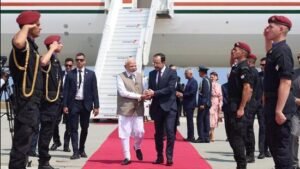
Why in News:
- On April 3, 2025, Indian Prime Minister Narendra Modi met Thailand’s Prime Minister Paetongtarn Shinawatra in Bangkok on the sidelines of the 6th BIMSTEC Leaders’ Summit.
- India and Thailand agreed to upgrade their bilateral ties to a “Strategic Partnership”, with special emphasis on cooperation in defence, digital technology, culture, and regional connectivity.
Introduction:
The article emphasizes the growing strategic significance of Thailand in India’s Act East and Indo-Pacific policies. As both countries gear up to enhance cooperation across various sectors, the relationship is being redefined with new energy. With the BIMSTEC (Bay of Bengal Initiative for Multi-Sectoral Technical and Economic Cooperation) summit as the backdrop, the visit is a critical moment in India’s regional diplomacy.
Point-wise Summary:
- India-Thailand Strategic Ties Upgraded:
- Prime Minister Modi and Thai PM Paetongtarn Shinawatra agreed to elevate India-Thailand relations to a “Strategic Partnership”.
- This move aims to deepen bilateral cooperation in security, economics, and regional affairs.
- Key Highlights from the Meeting:
- Modi arrived in Bangkok for a two-day visit, leading to a productive meeting with Thai leadership.
- Both leaders signed six important agreements, including:
- Establishment of a Strategic Partnership
- MoUs on digital technologies
- Collaboration on the National Maritime Heritage Complex (NMHC) at Lothal (Gujarat)
- Agreements on MSMEs, education, tourism, and culture
- Security and Border Cooperation:
- The two sides agreed to launch a “strategic dialogue” between their security agencies.
- Focus areas include:
- Maritime security
- Return of Indian fugitives
- Human trafficking and illegal migration
- Combating cybercrime and transnational crimes
- Economic and Cultural Collaboration:
- Modi emphasized deeper collaboration on:
- Micro, Small, and Medium Enterprises (MSMEs)
- Tourism and cultural exchanges
- Trade and investment from India’s northeastern states
- Act East and Indo-Pacific Vision:
- Modi reiterated that Thailand plays a key role in India’s Act East Policy and Indo-Pacific strategy.
- He stressed India’s vision of a free, open, inclusive, and rules-based Indo-Pacific.
- Advocated for development-oriented foreign policy over expansionism.
- Cultural and Historical Bonds:
- Modi referenced the spread of Buddhism and common cultural heritage.
- Mentioned historical linkages such as:
- Indian scholarship in Ayutthaya (ancient Thai capital)
- Shared folklore, languages, and religious texts
- Modi attended a Ramayana-themed performance, underlining cultural diplomacy.
- About PM Paetongtarn Shinawatra:
- 38-year-old Thai PM and daughter of former PM Thaksin Shinawatra
- Niece of another ex-PM Yingluck Shinawatra
- Modi praised Thaksin as a “great friend of India”
- Modi’s discussions with her included ideas on defence, trade, and regional cooperation
- ASEAN and Regional Outlook:
- Modi emphasized ASEAN’s role in maintaining regional peace and stability.
- India actively supports ASEAN unity.
- Highlighted India’s support for ASEAN-India maritime cooperation.
- BIMSTEC Summit Participation:
- Modi will participate in the 6th BIMSTEC Summit along with leaders from:
- Bangladesh, Sri Lanka, Nepal, Bhutan, Myanmar, Thailand
- India sees BIMSTEC as vital for regional connectivity and economic development.
- Modi is scheduled to meet leaders like:
- Sheikh Hasina (Bangladesh)
- Pushpa Kamal Dahal (Nepal)
- Mohamed Muizzu (Maldives)
- Min Aung Hlaing (Myanmar)
Notes (Explanation of Terms):
- Strategic Partnership:
A level of international relationship that involves collaboration on major issues like defence, security, trade, technology, and diplomacy, going beyond a regular bilateral relationship.
- Act East Policy:
India’s foreign policy initiative aimed at promoting economic and strategic relations with Southeast Asian countries, expanding its influence in the Asia-Pacific region.
- Indo-Pacific:
A geopolitical region combining the Indian Ocean and the Pacific Ocean, highlighting strategic maritime interests and regional security. India’s vision is based on freedom of navigation, rule of law, and economic growth.
- BIMSTEC (Bay of Bengal Initiative for Multi-Sectoral Technical and Economic Cooperation):
A regional organization of seven countries — India, Bangladesh, Bhutan, Nepal, Sri Lanka, Myanmar, and Thailand — that seeks to promote regional cooperation across multiple sectors like connectivity, trade, energy, and security.
- NMHC (National Maritime Heritage Complex):
A heritage project being developed at Lothal, Gujarat, to showcase India’s rich maritime history. It’s aimed at boosting heritage tourism and fostering regional cooperation on cultural preservation.
- ASEAN (Association of Southeast Asian Nations):
A regional organization of ten Southeast Asian countries that promotes political and economic cooperation. India has a strategic partnership with ASEAN and sees it as a key player in Indo-Pacific stability.
- Ayutthaya:
Ancient capital of Thailand with deep cultural and religious links to India, especially through Buddhism and ancient texts like the Ramayana.
- Paetongtarn Shinawatra:
Prime Minister of Thailand, from a politically influential family. Her appointment is seen as continuity in Thailand’s international outlook, with historical warmth toward India.
Relevance for CLAT Aspirants:
- Current Affairs (International Relations):
- Questions on India’s bilateral and multilateral relationships often appear.
- BIMSTEC, ASEAN, Act East, and Indo-Pacific are frequently tested topics.
- Legal GK and International Bodies:
- Aspirants must be aware of regional groupings, cooperation mechanisms, and how India engages with them.
- Analytical Reasoning:
- Understanding the strategic logic behind India’s foreign policy choices improves analytical depth.
- Essay Writing/Interview Preparation:
- These themes are excellent for essay prompts like:
- “India’s strategic pivot to Southeast Asia”
- “Significance of BIMSTEC in regional diplomacy”
- These themes are excellent for essay prompts like:
Conclusion:
The recent developments in India-Thailand relations signify a new strategic depth in India’s regional diplomacy. With Thailand being a bridge between South and Southeast Asia, its role is crucial in India’s Act East Policy and the broader Indo-Pacific strategy. For CLAT aspirants, understanding the strategic, economic, and cultural dimensions of such international relationships is essential for staying current and informed.






